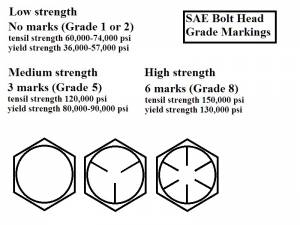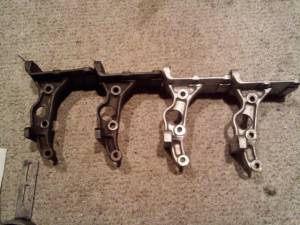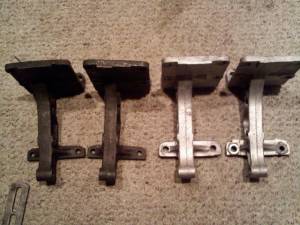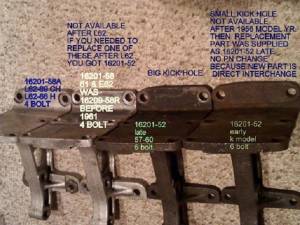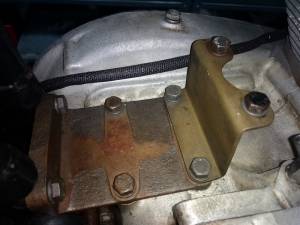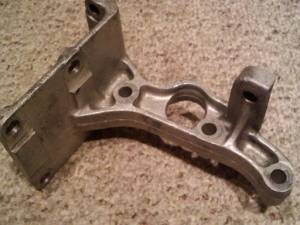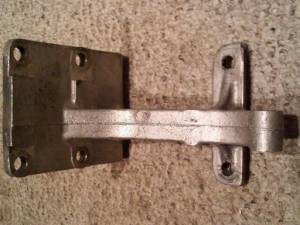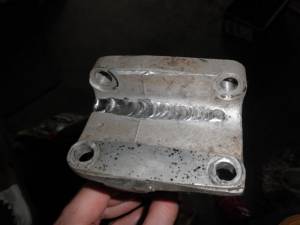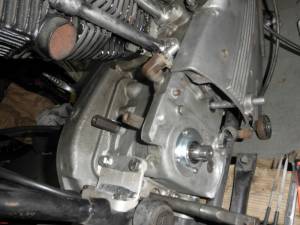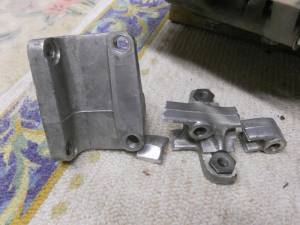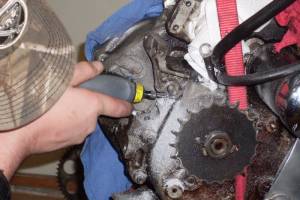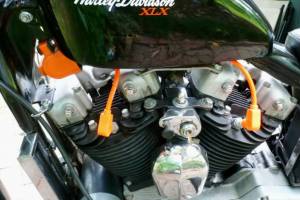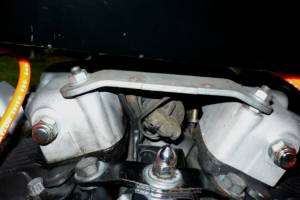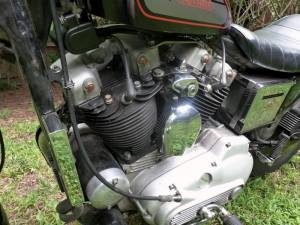Table of Contents
This is an old revision of the document!
IH: Engine Mechanical
Engine Mounts
This page has been created from XLForum posts and pics, era model Sportster parts catalogs, parts catalog supplements and pics / documentation from JW Boon.com or NOS Parts.nl. 1)
Removing / Installing Motor Mounts
The ironhead factory service manuals lay out the procedure for 'stripping the motorcycle for repair'.
This covers the procedure for removing / installing the motor and also includes the motor mounts.
However, the whole story is not in the manual.
You can induce added vibration and potential for cracks in the mounts or cases if the mounts aren't installed properly.
Below is the procedure from the manuals for removing and installing the mounts. 2) 3) 4)
To remove the motor (given all other particulars have been removed as this is strictly regarding the mounts themselves);
- 57-78:
Remove top engine support bolt located between the cylinders.
Be sure to note how many shim washers are between the head bracket and the frame lug so they can be re-installed with the engine.
79-85:
Remove the rear top engine support bracket and then the front top engine support bracket.
On 83-up engines, remove the VOES and then the rear top mount. - Remove the right crash bar bolt (if equipped).
- Loosen but do not remove the top front bolt from the lower left plate.
- Remove the three remaining bolts and left crash bar bolt (if equipped).
- Remove the two top bracket support bolts (1 from each head) along with the bracket assembly.
- Remove the two top rear engine mounting bolts and regulator ground strap.
- Remove the stoplight switch (66 and earlier), rear brake lever and spring (74 and earlier) and gear shift foot lever (75-up).
- Remove left footrest 78<.
- Remove the two bottom rear engine mounting bolts.
- Remove the top left bolt from the lower mounting plate.
(The 79-85 FSM simply states to remove the hardware that attaches the front and rear of the engine to the frame).
To install the motor (Again, this is strictly regarding the mounts themselves and all other parts will need to be addressed that were removed);
The 79-85 FSM doesn't give instructions on putting everything back together.
- Install the right crash bar bolt (if equipped).
- Install the two bottom rear engine mounting bolts
- Install the two top rear engine mounting bolts and regulator ground strap.
- Install the top left bolt from the lower mounting plate.
- Install the three remaining bolts and left crash bar bolt (if equipped).
- (It's assumed to tighten) the top front bolt from the lower left plate.
- Install the stoplight switch (66 and earlier), rear brake lever and spring (74 and earlier) and gear shift foot lever (75-up).
- Install the two top rear engine mounting bolts and regulator ground strap.
- 57-78:
Install the 2 top bracket support bolts (one on each head) along with the bracket assembly and the top engine support bolt located between the cylinders.
(Be sure reinstall the correct amount of shim washers as removed).
Further explanation of the tightening sequence:
When following the manual procedures, it's possible and actually common to tighten everything up only to find the motor position has cracked the rear mount.
Your motor needs to be “cradled” in the frame. 5)
If it's just put in and tightened up it could be out of alignment and stress one area more than others.
That can set up a harmonic that gets worse at a specific rpm range.
The way the rear mount is designed, it determines the motor location. 6) 7)
The rear mount has to be tightened first, then the other mounts.
It's possible to probable that most rear mount breakage can be attributed to improper assembly techniques, broken frames or loose / missing mounts.
You cannot “pull” the rear mount into place against the other mounts as it will break the mount due to the high amount of leverage from the other mounts.
The front frame tubes may spring sideways slightly but that is the only allowable “pulling”.
All mounts should fit nicely and naturally before tightening.
- The rear mount is fixed (as in not adjustable).
It has to be tightened first to the motor (snug the top 2 bolts, tighten the 3 lower nuts / bolts then tighten the top 2).
Then tighten the 4 frame to mount bolts before even installing the other mounts.
- After the rear mount is tightened, then install the front mounts.
Take care to keep the motor in it's natural position after rear mount is tightened. Do not pull or wedge the motor against the rear mount.
If things don't fit right, perhaps the frame is bent or the rear mount position on the motor needs to be adjusted (which is difficult if not impossible).
Keep in mind that all bolts must go through all of the parts without any binding AFTER the rear mount is tight.
Work on any front bolt holes with a rat tail file to slot any holes in the plates that do not line up perfectly.
(The bolts must pass through with no interference).
Pay special attention to the use and correct positioning of front mount spacers and grippy washers (OEM recommended).
NOTE:
There are many aftermarket front mount bolts that are longer to facilitate installing forward footpeg mounting brackets that get sandwiched with the mount plates.
Do not install a long bolt in the front mount upper rear position (you'll break the cases!). - After the front mount bolts are tightened, install the top mounting bracket(s).
Shim any gaps in the upper mount(s) or slot bolt holes as needed with large diameter washers.
The top mount should be shimmed if it does not fit nice against the frame.
Use hardened flat washers (soft washers will crush or taco and not hold correctly) over slotted holes and grade 8 nylock nuts.
Use hardened washers against aluminum also.
Pyramid stack hardened washers for the big single upper mount bolt.
Use a fender washer or make a large diameter shim if needed to close any gap (fine thread grade 8 bolt & nut).
All else fails;
There is sometimes some wiggle room on the rear mount. 8)
Loosen all the bolts slightly and give it a yank in the direction you need hold and tighten.
DO NOT pull things into position or jam bolts in under pressure!
The bolt holes must line up naturally or the rear mount will break in use.
Don't get in a rush, it will be costly later (regrets if nothing else).
You don't have time to NOT do it right. It will NOT get done later and will leave you beside the road when it breaks.
Put it together right the first time, or you will be forever breaking down.
Another way to do that is to hang the motor by the center (head mount) on the frame. 9)
Use no washers,leave the front mount bolts out and the front mounts loose at the engine.
Start all of your rear mount bolts but don't tighten them up yet. Start all of your front mount bolts but leave them loose.
Now tighten up the rear mount bolts evenly until the rear mount is seated and torque the bolts.
Snug up the front mounts but not tight. Remove the top mount and add washers until you have about 1/32“ play at the top mount. Tighten front mount bolts, frame and engine. Tighten top mount and you are done.
Bolt Type and Lengths
There are conflicting views on what grade bolts to use.
Some say it's best to use the original bolts which are grade 5 SAE fine thread (3/8”x24) and that grade 8 bolts are seen as overkill.
The theory is that a grade 8 bolt is more brittle and doesn't have as much elasticity as a grade 5 bolt.
And that upon a collision, a grade 8 bolt would break or shear whereas a grade 5 bolt would bend or deform (but still remain “intact”).
(That reasoning is debatable however. Both have been used successfully)
Others say a grade 8 bolt is always harder, and stronger in tensile and shear than a grade 5. 10)
(30,000 psi higher in tensile strength and 40,000-50,000 psi higher in shear strength).
If loaded to failure, grade 5 will have more % elongation than a grade 8 before it finally breaks, but will still break at a lower stress than a grade 8.
If fasteners are elongating that much in any application, there are other problems.
Lower grades are used to save cost over higher grades when cost is a factor. Lower grades offer no mechanical advantage.
The MoCo's first use of grade 8 motor mount bolts was in 1986.
Rear mount to case bolts \ studs
Rear studs
These are the three horizontal studs in the rear that the mount slides over and into the center valley between the cases.
The nuts secure the mount to the rear of the case.
- Stud (3ea)-(24817-52) 3/8“x3-1/4” grade 5 zinc, case end is threaded 3/8“x16, nut end is threaded 3/8”x24.
- Nut (3ea)-(7775, Flexlock) 3/8“x24 or (7775NY, Nylock) 3/8”x24x9/16“.
Top bolts / studs
These go in on the 'shelf' or top of the engine cases in the rear.
- 1957-1975 bolts: All
- 3/8”x16x1-3/16“ parkerized, hex head.
Part # (4348)
57-66 XLH/XLCH & 67-69 XLCH (4 ea.)
67-75 XL/XLH/XLS (2 ea.)
- L1970-E1975 studs:
- L70-E72 XLCH
1 bolt in the left side and a stud (24825-66) 3/8”x1-5/8“ parkerized in the right side.
The case side is 3/8”x16, the other side is 3/8“x24. - L72-E75 XLCH
1 bolt in the left side and a stud (24824-67) 3/8”x2“ grade 5 zinc in the right side.
The case side is 3/8”x16, the other side is 3/8“x24.
- 1976 XLCH bolts :
- 3/8”x16x1“ grade 5 zinc, hex head.
Part # (2879W) (2 ea.)
- 1976-1978 XL/XLH/XLS bolts :
- 3/8”x16x1“ grade 5 zinc, hex head
Part # (2879W) (2 ea.)
- 1977-1978 XLCH bolts:
- 3/8”x16x1-1/4“ grade 5 zinc, hex head
Part # (4716W) (2 ea).
- 1979-1985 All, bolts:
- 3/8”x16x1-1/4“ grade 5 zinc, hex head.
Part # (4716W) (2 ea).
Rear mount to frame bolts
Top bolts
- 1957-1962:
- 3/8”x24x1-1/8“ parkerized, hex head.
Part # (4336) (2 ea). - Replacement in 63 was 3/8”x24x1-1/8“ grade 5 zinc, hex head.
Part # (4336w) (2 ea).
- 1963-1972:
- 3/8”x24x1-1/8“ grade 5 zinc, hex head.
Part # (4336w) (2 ea).
- 1973-1978:
- 3/8”x24x2-1/4“ grade 5 zinc, hex head.
Part # (3945) (1ea). - 3/8”x24x1-1/8“ grade 5 zinc, hex head.
Part # (4336w) (1ea).
- 1979-1981:
- 3/8”x24x1-1/8“ grade 5 zinc, hex head.
Part # (4336w) (1ea). - 3/8x24x3” grade 5 zinc, hex head.
Part # (4415) (1 ea).
- 1982-E1983:
- 3/8“x24x3-3/4” grade 5 zinc, hex head.
Part # (3455) (2 ea).
- L1983-1985:
- 3/8“x24x3-3/4” grade 5 zinc, hex head.
Part # (3455) (1 ea). - 3/8x24x3-1/4“ grade 5 zinc, hex head.
Part # (4434W) (1 ea).
Bottom Bolts
- 1957-1960:
- 3/8”x24x2“ grade 5 zinc, hex head.
Part # (4380W) (2 ea).
- 1961-E1962:
- 3/8”x24x2-1/16“ cad, hex head.
Part # (4388B) (2 ea).
(although JW Boon lists this as 2-1/8” long) - Replacement in 76 was 3/8“x24x2” grade 5 zinc, hex head.
Part # (4380W) (2 ea) sold in 76 for 54-E62 models.
- L1962-1972:
- 3/8“x24x2-1/2” parkerized, hex head.
Part # (4452B - or HB) (2 ea). - Replacement in 76 was 3/8“x24x2-1/2” grade 5 zinc, hex head.
Part # (4412) (2 ea) sold in 76 for L62-up models.
- 1973-1978:
- 3/8“x24x2-1/2” grade 5 zinc, hex head.
Part # (4412) (2 ea).
- 1979-E1983:
- 3/8“x24x2-1/4” grade 5 zinc, hex head.
Part # (3945) (2ea).
- L1983-1990:
- 3/8“x24x3-1/2” grade 5 zinc, hex head.
Part # (4435W) (2 ea).
Lower front mount bolts
Use the spacers and single bolts of the correct length.
This keeps the frame tubes together around the sandwiched engine cases. Very important! 11)
Bolt lengths from parts catalogs (all have 3/8“x24 threads):
As you can see below, the lengths are far from being standard length and those lengths changed depending on what parts catalog you reference.
These are general guidelines for bolt sizes:
The front motor mount uses 3 different size bolt (lengths) for the 4 holes. 12)
The upper front and lower front holes (attaching to the frame) use the longest bolts.
The upper rear (through the case) uses the shortest.
The lower rear (through the case) uses the remaining middle length one.
If you use any other length bolts (in the case of the bolt going into the threaded engine plate at the top rear) use the 5-3/16” long bolt.
A longer bolt there will run into the generator mount and the lower one gets close to the oil pressure switch. 13)
-
- Top rear bolt (1), 5-3/16“ long (16235-52) grade 5 zinc.
Part number changed to (16235-52A) in the -78B catalog (issued in 1989) but the length stayed the same in the book.
Correct length is 3/8”x24x5-1/4“. - Bottom rear bolt (1), 5-7/16” long (16236-52) grade 5 zinc.
Changed to 5-1/2“ long (4413) in 1973 and sold for 54-76 models from the -78B catalog (issued in 1989). - Front bolts (2), 6-13/16” long (16237-57) grade 5 zinc.
'57 to '76 in the -78B catalog.
-
- Top rear bolt (1), 5-3/16“ long (16235-52) grade 5 zinc.
Changed to 5-1/4” long in -78A catalog (issued in 1981) for 77-78 models with the same part number for both lengths (16235-52).
The correct part number is (16235-52A) - Bottom rear bolt (1), 5-1/2“ long (4413) grade 5 zinc.
- Front bolts (2), 6-13/16” long (16237-57) grade 5 zinc.
-
- Top rear bolt (1), 6-13/16“ long (16237-57) grade 5 zinc.
Both the -79 and -79A parts books show a quantity of (3) for this size bolt (same size as the front two) instead of the 5-3/16” bolt.
Changed in 1980 to 5-1/4“ long which is part # (16235-52A) and correct for 1979 also. - Bottom rear bolt (1), 5-1/2” long (4413) grade 5 zinc.
- Front bolts (2), 6-13/16“ long (16237-57) grade 5 zinc.
-
- Top rear bolt (1), 5-1/4” long (16235-52) grade 5 zinc.
Shorter bolt with same part number as the longer bolt in 1978.
Part number changed to (16235-52A) in the -85A catalog (issued in 1990) but the length stayed the same in the book.
The correct part number is (16235-52A) at 5-1/4“ long. - Bottom rear bolt (1), 5-1/2” long (4413) grade 5 zinc.
- Front bolts (2), 6-13/16“ long (16237-57) grade 5 zinc.
Torque Specs
There are no torque specs for the motor mount bolts in the 57-78 FSMs.
And there is only value in the 79-85 FSM (rear motor mounting bolt-nut: 16 to 24 ft lbs).
For the rest, there is a “General Fastener Tightening Specifications” chart in the 70-78 and 79-85 FSMs. 30)
It lists general torque values for bolt types but not specific mounting bolts.
It also says to torque to these values given in the table unless specified otherwise.
| Bolt size | SAE 2 74,000 psi Low carbon | SAE 5 120,000 psi Medium carbon heat treat | SAE 7 133,000 psi Medium carbon alloy | SAE 8 150,000 psi Medium carbon alloy | Socket head cap screw 160,000 psi High carbon quenched tempered | Socket head set screw 212,000 psi High carbon quenched tempered | Studs |
| #6 | - | - | - | - | - | 9 in/lb | Use SAE 2,5 and 8 values when grade is known with nut and sufficient strength |
| #8 | - | 14 in/lb | - | - | - | 16 in/lb | |
| #10 | - | 22 in/lb | - | - | - | 30 in/lb | |
| 1/4” | 6 ft/lb | 10 ft/lb | 13 ft/lb | 14 ft/lb | 16 ft/lb | 70 in/lb | |
| 5/16“ | 12 ft/lb | 19 ft/lb | 25 ft/lb | 29 ft/lb | 33 ft/lb | 140 in/lb | |
| 3/8” | 20 ft/lb | 33 ft/lb | 44 ft/lb | 47 ft/lb | 54 ft/lb | 18 ft/lb | |
| 7/16“ | 32 ft/lb | 54 ft/lb | 71 ft/lb | 78 ft/lb | 84 ft/lb | 29 ft/lb | |
| 1/2” | 47 ft/lb | 78 ft/lb | 110 ft/lb | 119 ft/lb | 125 ft/lb | 43 ft/lb | |
| 9/16“ | 69 ft/lb | 114 ft/lb | 154 ft/lb | 169 ft/lb | 180 ft/lb | 63 ft/lb | |
| 5/8” | 96 ft/lb | 154 ft/lb | 215 ft/lb | 230 ft/lb | 250 ft/lb | 100 ft/lb | |
| 3/4“ | 155 ft/lb | 257 ft/lb | 360 ft/lb | 380 ft/lb | 400 ft/lb | 146 ft/lb | |
| 7/8” | 206 ft/lb | 382 ft/lb | 570 ft/lb | 600 ft/lb | 640 ft/lb | - | |
| 1“ | 310 ft/lb | 587 ft/lb | 840 ft/lb | 700 ft/lb | 970 ft/lb | - |
Rear Mounts
| Rear Motor Mount 32) | |||
| Part# | Year model | Hole for kicker | Notes |
| 16201-52 | 52-60 K Models/XL/XLH/XLCH | ✔ | 4 hole |
| 16201-58 | 61-E62 XLH/XLCH 67-69 XLCH | ✔ | 4 hole |
| 16201-58A | L62-66 XLH/XLCH 67-69 XLCH | ✔ | 4 hole |
| 16203-67 | 67-81 XL/XLH/XLS 70-81 XLCH | ✔ | 2 hole |
| 16203-82 | 82-83 All | ✘ | 2 hole. Replaced by 16203-82A. Appearance- cast |
| 16203-82A | 84-90 All | ✘ | 2 hole. Replacement for 16203-82. Appearance- billet |
The old rear mounts and the crankcase have 4 holes. 33)
When Harley changed to 2 hole mounts, all they did was knock the front 2 holes off the old mount and later eliminated the 2 front holes in the case.
But the hole spacing stayed the same.
So if you want to use a 4 hole mount on a 2 hole case;
All you have to do, if you should be so lucky to find a steel mount, is saw off the front 2 hole area of the mount.
If you want to use a 2 hole mount on a 4 hole case, you'll have to stick some short bolts in to plug the 2 unused case holes but it should fit just fine. 34)
Here are the 4 kick only (4 bolt) rear motor mounts. 35)
From left to right (each pic below):
- 1952-1956 k model (iron).
Note the smaller hole for kicker shaft. The K kicker shaft used a smaller thrust collar than XL. - 1957-E1962 (iron).
- The third is belived to be an XR or R model (aluminium).
It does not use and is not machined for the steel inserts for the lower bolts.
It came with a 60 XLR basket. - L1962-up uses the steel inserts for the lower bolts.
- 1982-1985 mount offsets the engine 13/32” to the left of the position for pre 1982 engines and don't have the hole in them for the kicker shaft to go through. 36)
The first 3 use the 2-1/16“ long lower bolts(when not using the passenger peg mount).
The late one uses 2-1/4” long lower bolts (when not using the passenger peg mount).
The key to understanding the evolution of these is knowing that 60-down used a 6 bolt lower battery tray and 61-up used a 4 bolt battery tray.
In order to use the 6 bolt battery tray (up to -52b) the mount needs to be milled clear across the upper flange (iron mounts).
When the aluminum was introduced, the battery tray was modified to the 4 bolt -52c.
The two bolts at top flange were no longer incorporated into the tray, so the mounts were not milled.
More 16201-58 pics:
This mount could be had in 1960 for $25.70
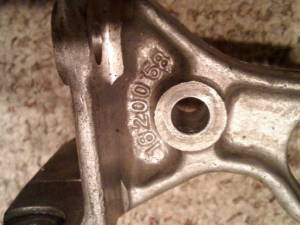 41)
41) 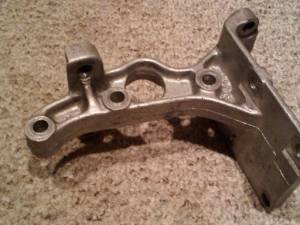 42)
42)
Broken / cracked rear mount
Originally, the rear motor mount was made of steel and had 4 bolts in the top. 45)
Later it was made of aluminum and prone to cracking. The steel mount will never crack.
The first aluminum mount had 4 bolts in the top. Later the mounts had only 2 bolts.
Aluminum mounts are going to crack. If you have a brand new replacement mount in hand right now, it will crack.
Should your mount be a steel one, then it is worth installing. But, the cracks do not present a real problem though.
That is the good news.
Sometimes the mount cracks all the way across as in the pics below.
Whilst many of them tend to crack, some only crack so far and then stabilize. 46)
Unless it's completely cracked through or flexing like mad, you can run it and monitor whether or not it gets worse.
So it's not necessarily a problem that has to be fixed depending on how badly cracked it is.
However, it does reduce vibration to repair or replace.
And even if the aluminum mounts are installed correctly, they will still crack. They seem to crack worse after welding. 47)
It may be best to score a 57-60 steel mount (a 52-56 k model mount will work too if you ain't got a kickstart) and cut it to mimic the -67 mount.
You can try to have the crack welded as in the pics below.
You can also replace it with an aftermarket mount. Pingel has a high reputation as an aftermarket alternative.
See Pingel Rear Motor Mount in the REF section of the Sportsterpedia.
The heavy aftermarket works but it takes up more room and you gotta screw around with the lower oil tank mount if you're working on a 70-78CH.
This one is cracked all the way across.
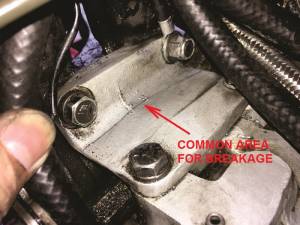 48)
48) 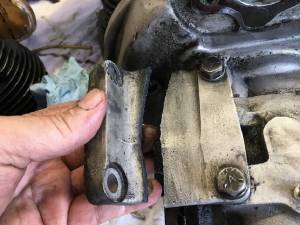 49)
49)
This one is only cracked for a small distance.
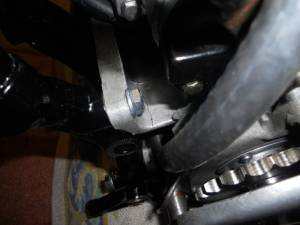 50)
50) 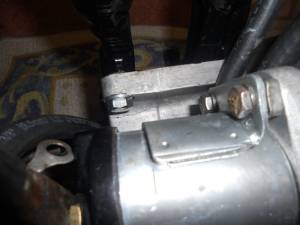 51)
51)
This one from a 68 XLCH has been welded.
Removing the rear mount
To remove the rear mount the engine has to come out of the frame and you generally have to split the cases unless can remove the studs. 54)
If you can remove the studs, splitting of the cases is not required.
Be advised though that these studs are not easy to remove.
They are factory installed into the left side case and it is a good guess that the factory did not want them coming out.
If you are replacing with an aftermarket rear mount such as a Pingel that slides on with the cases together, you can simply cut the old mount off.
Most aluminum mounts are going to crack and some have road years with the crack without fixing it as you've got like 6 bolts holding the mount to the engine and the frame. 55)
The left case (where the studs are screwed into) comes way back to the end of the primary cover on the left side of the rear mount.
The right case also comes back to the end around the transmission mainshaft.
So that leaves the rear motor mount sitting in the recessed area between the rear projections of both cases.
If you can remove the three studs the mount comes straight out the rear of the engine.
If you cannot get the studs out then you must split the cases.
If the engine is still in the frame, it will be hard to see what is being described.
You can remove the sprocket rightside cover and kick start lever (if equipped) and your view will be much improved.
This is a set of short frame cases but will work to show why the mount won't slide off. 56)
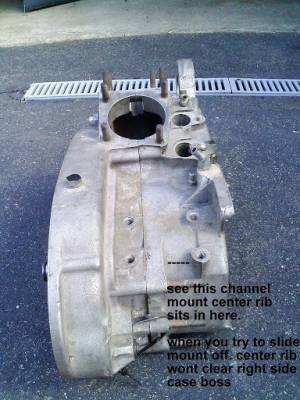 57)
57)
Examples of ways to cut the rear mount off without splitting the cases for a Pingel replacement mount.
Removing the studs
1976 and earlier used studs for both upper and lower holes. These studs were threaded into the left half crankcase and were installed TIGHTLY! 60)
(to the point that removing the studs for a motor mount replacement was never done as a general practice)
The crankcase halves were split to replace a broken mount.
Some have successfully removed the studs but if you screw them up, you are in big trouble, so be careful.
You may have to weld a nut on the end of the stud to get it out. Be sure to have a replacement stud in hand before doing this though.
That's probably why some will say to just run a cracked mount unless it gets too bad.
Although some have had luck with a stud extractor.
Also, you can double nut the stud, heat the area of aluminum around the stud (heat it, Not Cook It). 61)
Then with a box wrench, start to back the stud out. Once it breaks (first 1/2 turn) spray some WD40 on the threads and slowly back out the stud.
Using studs vs bolts on rear mounts
The stud (or bolt) is threaded into an aluminum casting (the case) which is not noted for having great strength. 62)
So the wise move is to use a stud threaded into the case using red Loctite.
The reason is because this is the only time the case threads get disturbed again.
Keep in mind the question, “Just why did the factory do this”?
They did it because there is good engineering reason to use a stud over a bolt.
When you tighten a nut on the stud the nut takes all of the beating and stress as it compresses against the motor mount, not the aluminum case.
If you want to use a bolt, then you should have a Heli-Coil installed in the case first.
Lower Front Mounts
| Sportster year model | Lower front mount (R) | Lower front mount (L) |
| 1957-1977 | 16210-52A (black) | 16213-52A (black) |
| 1978 | 16210-52B | 16213-52B |
| 1979 L1979 adition | 16210-52A (black) | 16213-52A (black) |
| 16210-77 (chrome) | 16213-77 (chrome) | |
| Replaced by 16210-79 (black) and 16213-79 (black) | ||
| 1980-1981 | 16210-79 (black) | 16213-79 (black) |
| 16210-77 (chrome) | 16213-77 (chrome) | |
| 1982-E1984 | 16210-81 (black) | 16213-81 (black) |
| L1984-1990 | 16210-84 (black) | 16212-84 (black) |
| 1957-E79 lower front motor mounts. 63) |
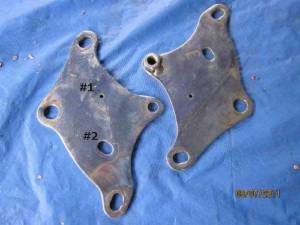 |
| 1982-E1984 lower front motor mounts / filter mount. (left shown) 64) See this page in the Sportsterpedia for building your own filter / motor mount for previous year models. |
|
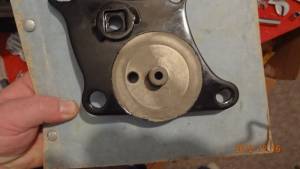 | 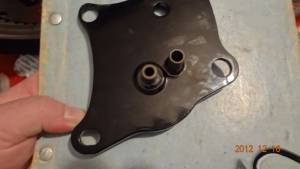 |
Specifics behind the assembly
- The key to what the factory did is the 4 holes in the plates (2 for plate to case & 2 for plate to frame) 65)
- Let's look at case holes in the plates 1st.
The top hole (this is the one that has the nut welded on the right side plate) is round and fits closely to bolt diameter.
When this bolt gets put together, the plates are located to the case cause the plate hole isn't sloppy on the bolt.
This is the “master” bolt. (although the plate can rotate using the bolt as an axle until you put in the lower case bolt). - Now look at the plate hole for the lower case bolt.
Its slotted in a way that the plate can rotate about the upper case bolt even when the lower bolt get put in.
This rotary play allows the plates to rotate so the upper frame plate bolt holes in them can line up to the upper holes in frame. - Now these upper frame bolt holes are slotted in the plate too (forward to back).
This is so the bolt will pass thru if different bikes have slightly different frame to motor distances.
But when this bolt gets put in, because of the direction of it's slot, the plates no longer can rotate.
So what you got now is a setup that has the ability to assemble to a big difference in motor / frame alignment, but still not be sloppy. - The last bolt goes thru a big round plate hole. It don't have anything to do with alignment.
The hole is big and round so the last bolt will align no matter how the 1st 3 fit. - What the grooves in the hardened washers do is bite into the face of the plates over the slots and the big over sized lower frame plate hole.
(hence nicknamed “Biter Washers”)
This stops the possibility of the plates sliding in those slots during operation.
The grooves lock the plates to the bolts (6 slots / big holes, 6 grooved washers with the grooves against plates).
Order of bolt / washer installation
The washers have concentric ridges on one side only (affectionately known as biter washers).
The hardened washers described below are the biter washers. 66)
The gripper side of each washer goes toward it's corresponding plate.
On 57-76 models, all the lower front mount bolts install from the left side. 67)
On 77-85 models with the gerotor oil pump, the bolts install from the left side with the exception of the bottom rear bolt that installs into the right side.
(The bolt head and washer takes up less space than the bolt end, washer and nut. So that leaves more clearance for the green wire/nut from the oil switch.)
- There are five of the hardened washers required for the front motor mounts 76< motors and six for 77-up motors.
- There are two motor mount plates.
- There are 4 motor mount bolts. Two we will call front upper and lower. The other two we will refer to as rear upper and lower bolts.
- Front upper bolt:
- Install a hardened washer against the head of the bolt.
- Slip bolt through upper hole in front left engine plate.
- Slip bolt through frame.
- Install spacer on bolt.
- Install hardened washer.
- Install right engine plate. (Right side engine plate sits inside the frame)
- Slip bolt through frame on right side.
- Install nut and flat washer.
- Front lower bolt:
- Done the same as above.
- Rear lower bolt:
- Done the same as above, except:
- No spacer is used. Run the bolt through the crankcase.
- The right side engine plate rests against the crankcase.
- Hardened washer is installed on bolt.
- Install nut and flat washer.
- Rear upper bolt:
- This is the odd one. Install a lock washer against the head of the bolt.
- Insert bolt into left engine plate.
- Run bolt through engine crankcase.
- This bolt will thread into the welded on nut sitting on the left side engine plate.
Top Mounts
1957-1976 top mount
(head to head straddle mount or center mount):
This mount is engineered to deal with any production tolerances and most owner created misalignments and is the first thing to assemble on top. 68)
There are three straddle mounts;
- 1957-E1971 (factory fitted with the -57 head castings).
You shouldn't use this mount on any other head casting with out checking for clearance. - L1971-1976 factory fitment.
This part can be used on all 57-76 no matter what heads you are running. - 1977-1985. All 3 holes are slotted.
This should not be used on 76< frames.
- Assemble the straddle to the heads:
- 1/8“ thick 1” dia. washers go BETWEEN each head and the bottom of the front-rear straddle mount.
Then the bolts (7/16“-20 X 7/8” bolts 5/8“ hex size) get put in.
The head is machined where this washer sits. The washer raises the strap above any unmachined nubs around the washer seat. 71)
It keeps interference at bay. If you look at the different strap profiles, you see the 1000 mount is also relived for nub clearance.
The 900 strap is not relived and when you see heads that are broke at the tapped hole, you will see most are 900.
Busting the mount lugs is because the washers are put on top smashing the strap into the nubs and splitting the head. - No washer between the bolt and the top of straddle mount. Both the versions of straddle mounts get assembled the same.
- The cross mount;
- Gets placed under the straddle mount (all years)
- Gets bolted with no washers (58-64).
- 57 gets the choke mount placed under the cross mount.
- 65-76 uses the stud in the horn mount instead of the bolt.
- 66 gets the choke lever assembly added to top side of straddle.
- Install Flexloc or Nyloc nut.
- The cross mount to frame;
- You will notice there is a giant space between the frame and the cross mount.
- The cross mount and the frame surfaces will be parallel. If they aren't then something is amiss.
- Select the correct pair of washers to fill 'your' space between the cross mount and the frame. This will take two of the three washers.
- Take the remaining washer and slip it over the bolt. Both get slid in from the bottom, thru the cross mount, washer stack, and frame bracket with the nut on top.
- At this point you got:
- Three 1 1/8” OD washers (two thick (.160“) and 1 thin (.090”/.110“ depending on what year).
- A Flexloc or Nyloc nut
- A bolt either 13/16” hex head 57-E72 (this bolt may be crossed drilled for a cotter pin/safety wire for R model use), or 5/8“ hex L72-76.
- This bolt eventually goes in from bottom.
| Top motor mount on 1971 XLCH. 72) | ||
 |  |  |
1977-1985 top mounts
1977-1985 motors have three mounts up top; a front, center and a rear mount.
There are 2 different top front mounts, 2 head to head center mounts (1 black, 1 chrome) and 3 different top rear mounts.
Don't forget to shim as needed.
-
- The top front bracket (16265-76) is an “L” shaped piece with 3 mounting holes.
It attaches to the front two rocker cover studs (3412) and to the frame neck by a bolt (3991) that screws in upwards.
If the front of the frame is stock, you should see the threaded hole by looking up with a flashlight.
It should be a 5/16”-18 x 7/8“ hex head.
The upper front mount can be tedious to install. Easiest to install while installing the rocker cover while things are loose. 75) - The center head straddle mount (16250-57) between the heads is black except for 79-E83 XLS which is chrome (16276-79).
It is not an actual motor mount but does keep structural integrity between the heads. - The top rear bracket (16266-76) has a hole and two open slots.
It attaches to the two left side rocker cover studs (3412) and to a bolt that runs thru a tube that is welded to the frame.
Order of install from bottom to top: rocker-washer-stud-bracket-washer-nut. 76)
However, you do have to check as they sometimes need an extra washer to ensure that the weight/force of the engine is on the bracket.
- 1982-E1983 XL / XLX, E83 XLS:
- The top front bracket (16214-81) is a wide “L” shaped piece with 4 mounting holes.
- The center straddle mount (16250-57) between the heads is black except for 79-E83 XLS which is chrome (16276-79)
- The rear top bracket (16277-81) is a “T” shaped plate with 3 mounting holes.
- 1982 XLS / E1983 XL:
- The top front bracket (16214-81) is a wide “L” shaped piece with 4 mounting holes.
- The center straddle mount (16250-57) between the heads is black except for 1979-E1983 XLS which is chrome (16276-79)
- The rear top bracket (61021-82) is 2 piece with a “T” shaped plate with a welded extension and an interlocking straight bracket.
- L1983-1985 XL / XLX / XLS:
- The top front bracket (16214-81) is a wide “L” shaped piece with 4 mounting holes.
- The center straddle mount (16250-57) between the heads is black except for 1979-E1983 XLS which is chrome (16276-79)
- The rear top bracket (16277-81A) is a “T” shaped plate with 3 mounting holes and an additional hole in the middle.
On 1977-up motors, two washers go on each bolt; one under the mount, one on top. This setup also uses the head strap that has the oblong holes. 77)
This isn't a motor mount on 77-up.
The parts book illustration is wrong. Check the FSM pics under “stripping bike for engine repair” and you will see the washer under the strap.
| 1977 XLCH top motor mounts. 80) | ||
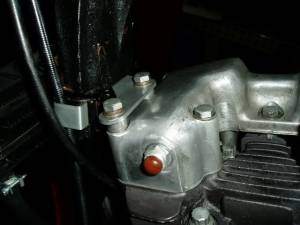 | 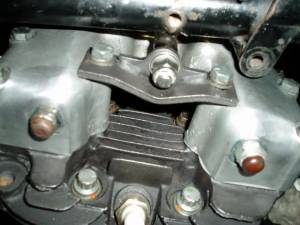 | 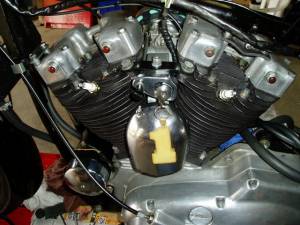 |
| 1977 XLH top motor mounts. 81) | ||
 |  |  |
| 1982 XLH top motor mounts. 82) | ||
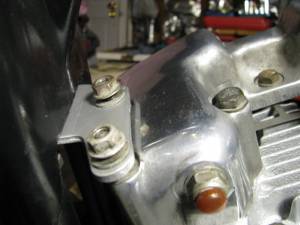 | 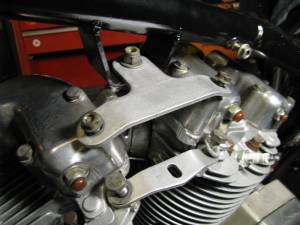 | 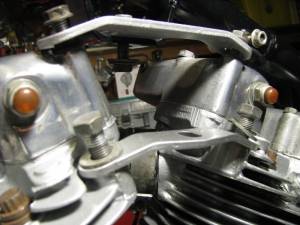 |

